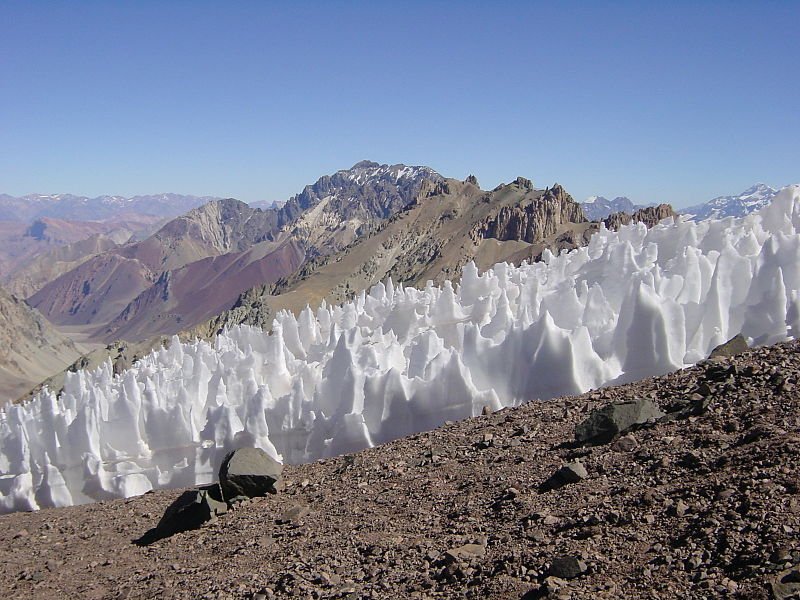Hello steemians! This is another post on the Bizarre Natural Phenomena series! For this post I'd like to take you on an imaginary trip to the high mountains of the Andes. Try to picture our hike on the icy mountains, tired with the load of our backpacks feeling heavier and heavier, our breaths becoming even more difficult to take, sweat drops forming over our bodies and right there you see it... an army of icy spikes lining up before our eyes, as if they're waiting for an invisible general's call before they are launched to a battle field (In my mind, I could picture the Night King using the power of his mind to move those spears of ice against humans over a frosted battlefield).

(Image source: wikipedia.org)
Don't worry though, those spears of ice are not weapons and no warlike mountain tribe is going to attack us. We just came across a cluster of penitentes.
Penitentes? Do they have to do with penitence?
No, they are not the frozen remnants of penitents that got lost in the mountains and died praying for salvation. Penitentes (or nieves penitentes, spanish for "penitent-shaped snow") are ice formations that got their name because of their resemblance to the white, pointed hats of an order of spanish monks. They were primarily reported by Charles Darwin in 1835 on his journey from Santiago (Chile) to Mendoza (Argentina) and there have been a few theories as to how they are formed.
Theories?
Yes, scientists have not completely understood how those spikes grow. Initially it was believed that the cold and dry winds of the Andes were to blame. Then some thought it was the cracks over the snowy slopes or the effect of sunlight over the snow. Another idea was that the electromagnetic orientation of snow crystals resulted in those formations or that wind and rain worked together to sculpt those ice spikes.

(Image source: wikipedia.org)
Formation
Sublimation is the sculptor behind this amazing artwork. Up in the dry and cold Andes the snow does not melt easily, but it sublimes. Near the equator sun rays fall directly down to the ground all year long. As they fall on the snow they skip the water phase and turn it immediately to vapor. The sunlight gets trapped in the tiny crests and troughs that you can find in even the smoothest layers of snow. Inside those depressions the light is concentrated, increasing the temperature and leading to further deepening of those "ditches". The spikes that are formed lean towards the sun in order to avoid excessive exposure to the sun's radiation. Penitentes are formed with last year's snow, but if they happen to lie over a glacier, the "carving" may get deep enough to reach the ice layer. Their height ranges from a few centimeters to even 4 meters (the tallest to be observed).
In 2006, Vance Bergeron (Ecole Normale Supérieure, Paris) and his team conducted a study. The scientists performed lab experiments and concluded that, since penitentes serve to cool the melting of ice down by casting their protective shadows over the glaciers, a future decrease in their number would speed up the glacier melting. The effects could be dramatic on the agriculture of Chile and Argentina that rely on those frozen water deposits. Another finding of this study was that when sprinkling carbon powder over the penitentes, they would grow faster. That made them believe that presence of dirt would help elongating the glacier's life expectancy. This last hypothesis was negatively criticized by Stephen Warren, a geophysicist from the University of Washington (Seattle).

(Image source: wikimedia.org)
A more recent study in 2015 by Philippe Claudin (Institute of Industrial Physics and Chemistry - ESPCI ParisTech) and his team, worked to fill the gaps in the former studies, regarding the distance between the penitentes. Within the melting "ditches" temperature is higher than in the surface because the radiation of the sun is absorbed better through reflection within the cavity. This means there is a temperature gradient between the surface and the hollows forming below. The air saturation also plays its part, since when the air on the surface is saturated, sublimation is hindered (there is no room for extra vapor). The team have found that vapor diffusion on the surface plays an important role in the distance between the penitentes, as when it happens very fast, the distance between the blades of ice increases.
Scientists believe that penitentes might be present over the surface of Europa, one of Jupiter's moons. Measurements have shown that around its equator there must be an oddly cold mass that reflects poorly on our radars.
You can watch this timelapse video from youtube and admire the penitentes' formation, growth and deterioration over the course of the seasons:
References
physics.aps.org_1 _ physics.aps.org_2
amusingplanet.com
scientificamerican.com
igsoc.org_1 _ igsoc.org_2
gizmodo.com
treehugger.com
wikipedia.org
physicstoday.scitation.org

Thank you for stopping by and giving this post a read. I hope you enjoyed it!
If it got your curiosity-radar on, feel free to follow me, @ruth-girl, for more fascinating phenomena!
You can also check some of the previous articles on this series:
16 - The Clone Forest
17 - A Skypunch
18 - Lake Baikal
19 - Mother-Of-Pearls Clouds
20 - The Hessdalen Lights
21 - St Elmo's Fire

And for those engaging with education, @steemiteducation is here to join all steemian educators in their common cause of making our job easier, more effective and more fun, because...

(Original image credits: Nick Youngson - nyphotographic.com)
Finally, the greek community of steemit is here and waiting for you to discover it! Follow the @greek-trail for daily doses of good-quality posts by wonderful writers!
Until my next post,
Steem on, people, and keep smiling!


